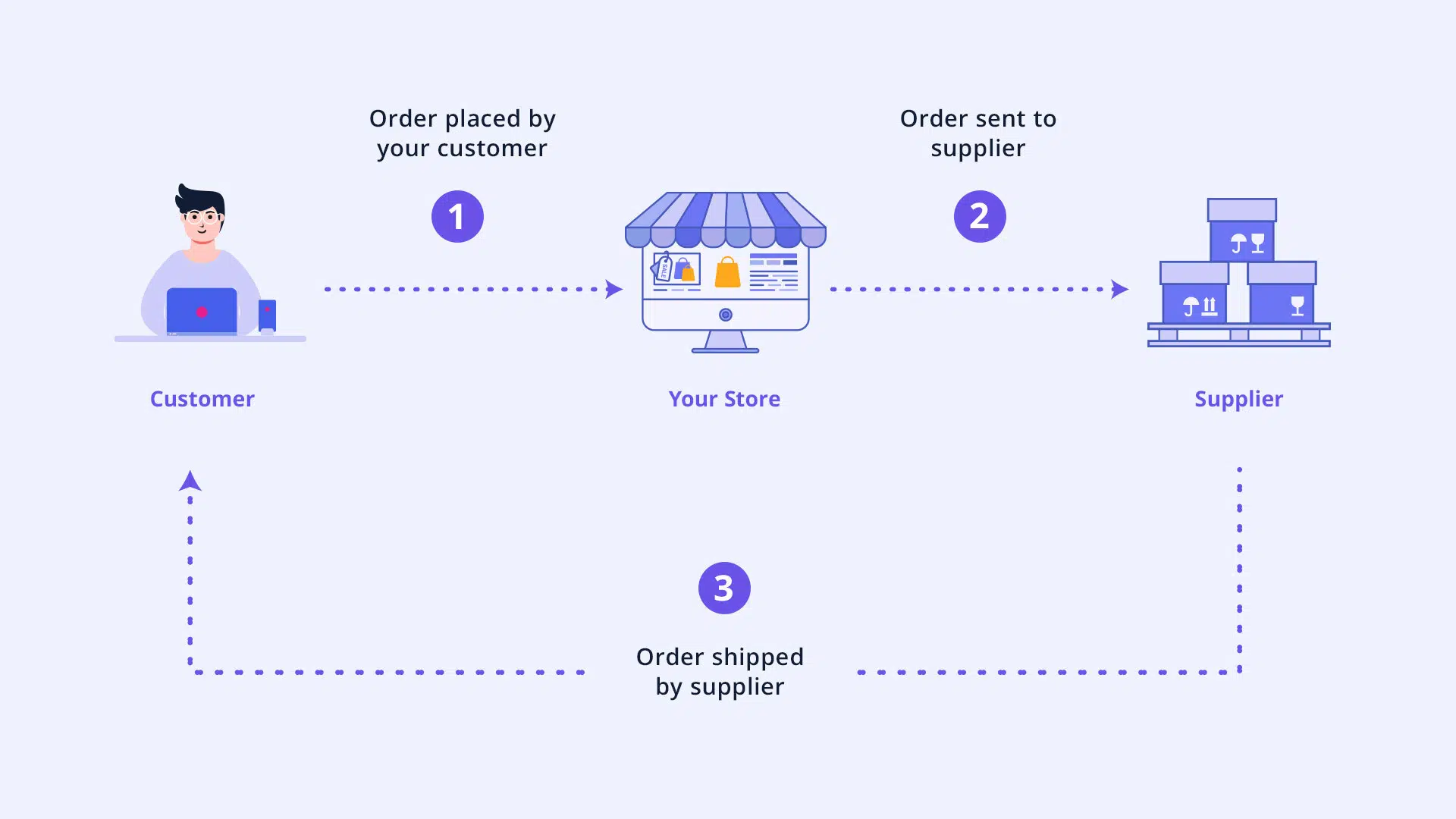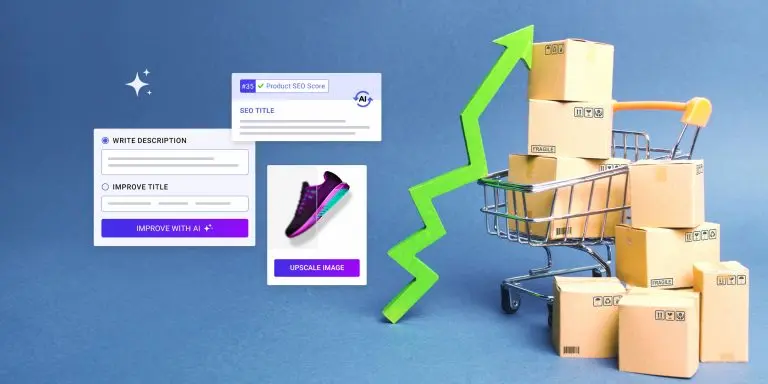In our ongoing series exploring the various ecommerce product sourcing methods, we’ve already explored dropshipping vs. print on demand and Amazon FBA vs. dropshipping. Now, it’s time for another essential distinction: dropshipping vs. wholesale.
Both business models have their pros and cons, and each suits different types of entrepreneurs depending on factors like budget, control, and time investment. Understanding the key differences between dropshipping and wholesale can help you determine which model best suits your ecommerce goals.
Let’s explore these two popular options in-depth to help you choose the right path for starting an online store.
Table of Contents
What is dropshipping?
Dropshipping is a business model where the retailer doesn’t hold any inventory. Instead, you sell products through your online store, and once a customer places an order, you purchase the item from a third-party supplier who ships it directly to the customer. In this model, you never handle the product physically.
How dropshipping works
- A customer places an order on your online store.
- You forward the order details to your supplier.
- The supplier ships the product directly to the customer.
- You keep the profit, which is the difference between the retail price and the supplier’s cost.

Read more: 40+ Most Popular Questions About Dropshipping
What is wholesale?
Wholesale, on the other hand, involves buying products in bulk directly from manufacturers or distributors at a discounted price. You, the retailer, then store the products and sell them at a marked-up price. With wholesale, you are responsible for managing inventory, packing, and shipping orders to customers.
How wholesale works
- You buy products in bulk from a supplier or manufacturer at a discounted rate.
- You store the inventory in a warehouse or storage space.
- When customers place an order, you pack and ship the product yourself.
- Your profit comes from the markup you apply to the bulk-purchased goods.
Key differences between dropshipping and wholesale
While both dropshipping and wholesale involve selling products online, the two models differ significantly in terms of investment, control, fulfillment process, and profitability. Let’s break down the major differences.
1. Upfront costs and investment
One of the primary distinctions between dropshipping and wholesale is the amount of upfront capital required.
For dropshipping the initial investment is minimal because you don’t need to purchase products upfront. All you need to do is find products and suppliers to source your products from and then set up an online store and start marketing the products. You pay for the product only after a customer makes a purchase.
In contrast, wholesale requires a significant upfront investment because you need to buy products in bulk. This also means you need storage space, whether it’s in your home, office, or a rented warehouse.
Read more: The True Cost of Dropshipping
2. Inventory management
Inventory management is another crucial factor in choosing between dropshipping and wholesale.
Since you don’t hold any inventory, if you decide to start dropshipping, this eliminates the hassle of managing stock levels, storing products, and dealing with dead stock. Your supplier handles everything related to the inventory.
In a wholesale model, you are responsible for storing, organizing, and managing your inventory. You need to monitor stock levels and ensure products are available when customers place orders. If you overestimate demand, you may end up with unsold stock.
3. Suppliers
Whether you’re operating a dropshipping or wholesale model, having a reliable supplier is crucial to your business’s sustainability and customer satisfaction. However, there are distinct differences in how suppliers are managed between the two models.
Working with dropshipping suppliers is generally easier and more accessible. While some dropshipping suppliers also require approval, it’s less common, making it easier for new entrepreneurs to get started.
Additionally, there are several online marketplaces and platforms, such as AppScenic, that simplify the process of finding reliable dropshipping suppliers. These platforms offer a wide range of products, often with automated tools to manage inventory, product listings, and order fulfillment.
When it comes to buying wholesale, you often work directly with brands or manufacturers. Many of these companies require you to seek approval before you can resell their products, particularly if you’re dealing with well-known brands.
Approval processes can be stringent, with some brands only allowing businesses with an established sales history to resell their products. Additionally, depending on your niche, finding a reputable wholesale supplier can be a time-consuming process.
While there are supplier directories that list vendors based on product categories, many suppliers are not listed online, which may require a more manual search or networking to establish the right connections.
4. Control and branding
Control over the product and branding is another key difference between dropshipping and wholesale.
In dropshipping, you have limited control over the product quality, packaging, and delivery times since everything is handled by your supplier. Branding customization is often minimal unless you partner with suppliers who allow private labeling.
With wholesale, you have full control over the product’s branding, packaging, and delivery. You can customize the experience to align with your brand and create a more unique customer experience.
5. Fulfillment and shipping
Order fulfillment and shipping logistics also differ significantly between dropshipping and wholesale.
When dropshipping, your supplier takes care of fulfillment and shipping. While this saves you time, it also means you have little control over shipping speed and packaging quality. Long shipping times (especially from overseas suppliers) can frustrate customers. So, to overcome this challenge, make sure you work with a local supplier that offers fast delivery times. Or choose a dropshipping platform like AppScenic that works only with fast shipping reliable suppliers.
In the wholesale model, you handle fulfillment and shipping. This gives you greater control over shipping times and packaging but requires more effort and resources. You must have a system in place for picking, packing, and shipping items promptly.
6. Profit margins
Profit margins tend to vary between dropshipping and wholesale, primarily due to how products are sourced and the costs associated with each model.
Profit margins are generally lower in dropshipping because you are purchasing products at retail prices (or near retail) from the supplier. The lower upfront investment makes dropshipping less risky, but the profits per sale are slimmer.
Wholesale generally offers higher profit margins since you’re purchasing products at a discount when buying in bulk. However, the initial investment is higher, and there’s a risk of unsold stock affecting your profits.
7. Risk factor
The level of risk is also a factor to consider.
The risk in dropshipping is lower in terms of financial investment. Since you’re not buying inventory upfront, you don’t have to worry about unsold stock. However, you might face issues like unreliable suppliers or low-quality products, which can harm your reputation.
With wholesale, the financial risk is higher because you’re purchasing inventory in advance. If you can’t sell the products, you may face significant losses. On the other hand, you have more control over product quality and supplier relationships, which can reduce reputational risk.

Pros and cons of dropshipping
Pros
- Low startup costs: You only pay for a product when it sells, making it accessible to entrepreneurs with limited budgets.
- No inventory management: The supplier handles warehousing and shipping, which frees up your time.
- Flexibility: You can run a dropshipping business from anywhere, as long as you have an internet connection.
Cons
- Low profit margins: Since you’re paying close to retail prices, you’ll need high sales volumes to generate substantial profits.
- Limited control: You rely on suppliers for product quality, shipping, and customer satisfaction.
- Competition: Dropshipping markets can be oversaturated, making it harder to stand out.
Pros and cons of wholesale
Pros
- Higher profit margins: Buying products in bulk allows for greater profit margins compared to dropshipping.
- Greater control: You have full control over inventory, fulfillment, and branding, which allows for a more customized customer experience.
- Product availability: With inventory on hand, you can offer faster shipping times, which leads to better customer satisfaction.
Cons
- High upfront costs: You need significant capital to purchase inventory in bulk and manage storage.
- Inventory risks: Unsold stock can lead to financial losses and the need for markdowns to move stagnant inventory.
- More time-consuming: Managing inventory, fulfilling orders, and handling logistics require more time and resources compared to dropshipping.
How to choose the right model for your business
The decision between dropshipping and wholesale largely depends on your goals, budget, and willingness to manage different aspects of the business. Here are some factors to consider:
- Budget: If you have limited funds and don’t want to invest heavily upfront, dropshipping is a safer option. On the other hand, if you have more capital and want to maximize profit margins, wholesale might be a better fit.
- Control: If you value control over your products, branding, and customer experience, wholesale offers more customization and authority over the entire process.
- Time commitment: Dropshipping is ideal for entrepreneurs looking for a more hands-off approach, while wholesale requires more time spent on inventory management and order fulfillment.
- Profit potential: While wholesale offers higher profit margins, it also carries greater financial risk. Dropshipping offers lower margins but mitigates the risk of unsold inventory.
Conclusion
So, both dropshipping and wholesale can be great business models, each with its own advantages and challenges. If you’re looking for a low-risk, flexible option with minimal upfront investment, dropshipping may be the right choice.
However, if you prefer greater control over your business and are willing to invest in inventory upfront, wholesale could offer better profit margins and customization opportunities.











